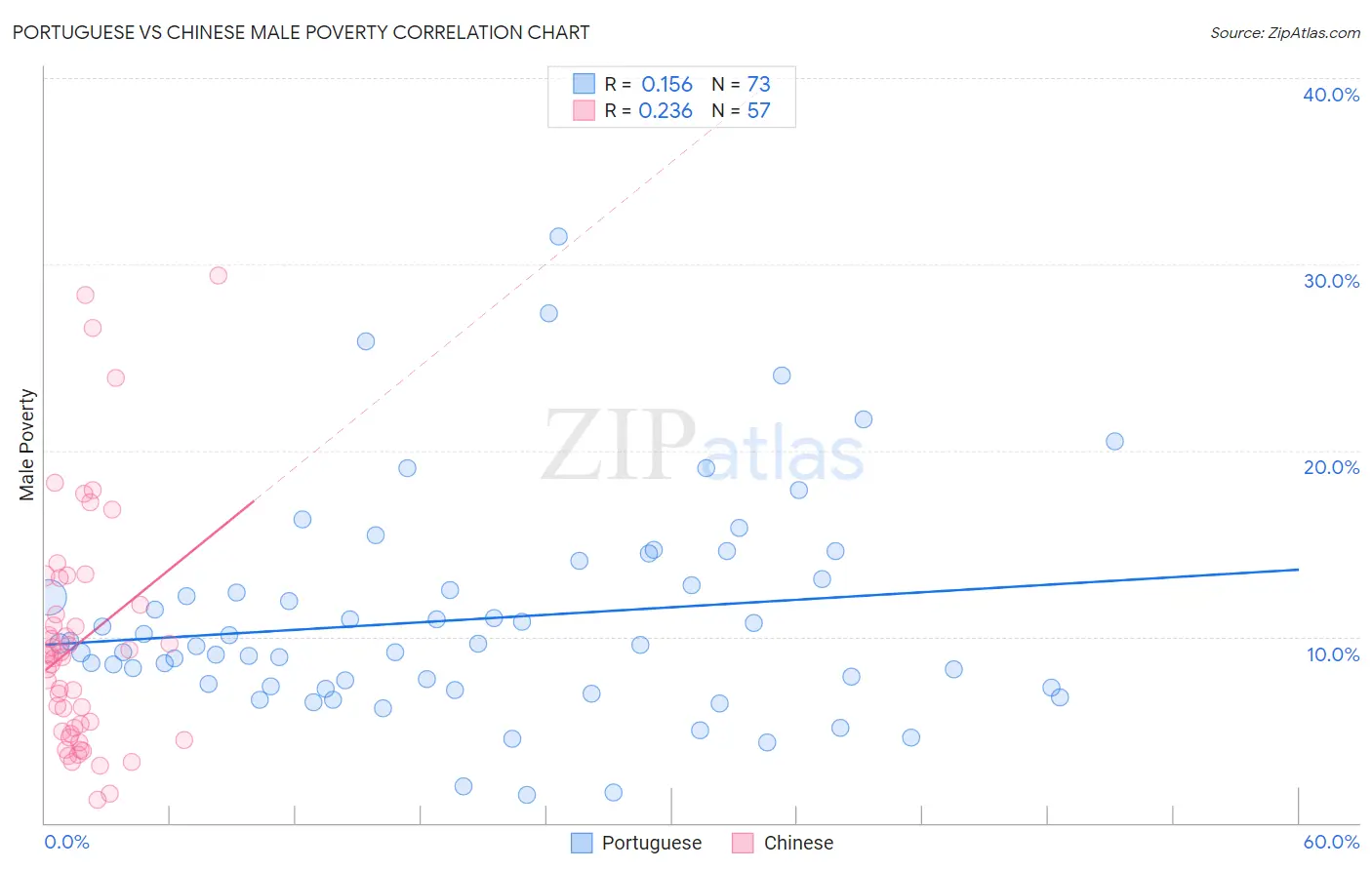Portuguese vs Chinese Male Poverty
COMPARE
Portuguese
Chinese
Male Poverty
Male Poverty Comparison
Portuguese
Chinese
10.6%
MALE POVERTY
91.0/ 100
METRIC RATING
108th/ 347
METRIC RANK
8.7%
MALE POVERTY
100.0/ 100
METRIC RATING
2nd/ 347
METRIC RANK
Portuguese vs Chinese Male Poverty Correlation Chart
The statistical analysis conducted on geographies consisting of 449,699,764 people shows a poor positive correlation between the proportion of Portuguese and poverty level among males in the United States with a correlation coefficient (R) of 0.156 and weighted average of 10.6%. Similarly, the statistical analysis conducted on geographies consisting of 64,801,112 people shows a weak positive correlation between the proportion of Chinese and poverty level among males in the United States with a correlation coefficient (R) of 0.236 and weighted average of 8.7%, a difference of 21.5%.

Male Poverty Correlation Summary
| Measurement | Portuguese | Chinese |
| Minimum | 1.5% | 1.3% |
| Maximum | 31.5% | 29.4% |
| Range | 30.0% | 28.2% |
| Mean | 10.9% | 9.7% |
| Median | 9.6% | 8.9% |
| Interquartile 25% (IQ1) | 7.3% | 4.8% |
| Interquartile 75% (IQ3) | 12.9% | 12.4% |
| Interquartile Range (IQR) | 5.6% | 7.6% |
| Standard Deviation (Sample) | 5.7% | 6.4% |
| Standard Deviation (Population) | 5.7% | 6.4% |
Similar Demographics by Male Poverty
Demographics Similar to Portuguese by Male Poverty
In terms of male poverty, the demographic groups most similar to Portuguese are Laotian (10.5%, a difference of 0.070%), Immigrants from Southern Europe (10.5%, a difference of 0.080%), Albanian (10.6%, a difference of 0.13%), Canadian (10.5%, a difference of 0.20%), and Welsh (10.5%, a difference of 0.21%).
| Demographics | Rating | Rank | Male Poverty |
| Immigrants | Zimbabwe | 92.0 /100 | #101 | Exceptional 10.5% |
| French Canadians | 91.9 /100 | #102 | Exceptional 10.5% |
| Slavs | 91.7 /100 | #103 | Exceptional 10.5% |
| Welsh | 91.6 /100 | #104 | Exceptional 10.5% |
| Canadians | 91.6 /100 | #105 | Exceptional 10.5% |
| Immigrants | Southern Europe | 91.3 /100 | #106 | Exceptional 10.5% |
| Laotians | 91.2 /100 | #107 | Exceptional 10.5% |
| Portuguese | 91.0 /100 | #108 | Exceptional 10.6% |
| Albanians | 90.6 /100 | #109 | Exceptional 10.6% |
| Argentineans | 90.1 /100 | #110 | Exceptional 10.6% |
| Immigrants | Argentina | 89.8 /100 | #111 | Excellent 10.6% |
| Immigrants | Turkey | 89.5 /100 | #112 | Excellent 10.6% |
| Palestinians | 89.1 /100 | #113 | Excellent 10.6% |
| Immigrants | Brazil | 89.0 /100 | #114 | Excellent 10.6% |
| Immigrants | Russia | 88.6 /100 | #115 | Excellent 10.6% |
Demographics Similar to Chinese by Male Poverty
In terms of male poverty, the demographic groups most similar to Chinese are Thai (8.7%, a difference of 0.080%), Immigrants from Taiwan (8.9%, a difference of 2.4%), Maltese (9.1%, a difference of 4.4%), Assyrian/Chaldean/Syriac (9.1%, a difference of 5.1%), and Immigrants from Ireland (9.1%, a difference of 5.2%).
| Demographics | Rating | Rank | Male Poverty |
| Immigrants | India | 100.0 /100 | #1 | Exceptional 8.2% |
| Chinese | 100.0 /100 | #2 | Exceptional 8.7% |
| Thais | 100.0 /100 | #3 | Exceptional 8.7% |
| Immigrants | Taiwan | 100.0 /100 | #4 | Exceptional 8.9% |
| Maltese | 100.0 /100 | #5 | Exceptional 9.1% |
| Assyrians/Chaldeans/Syriacs | 99.9 /100 | #6 | Exceptional 9.1% |
| Immigrants | Ireland | 99.9 /100 | #7 | Exceptional 9.1% |
| Filipinos | 99.9 /100 | #8 | Exceptional 9.2% |
| Immigrants | South Central Asia | 99.9 /100 | #9 | Exceptional 9.3% |
| Bulgarians | 99.9 /100 | #10 | Exceptional 9.3% |
| Bolivians | 99.9 /100 | #11 | Exceptional 9.4% |
| Immigrants | Bolivia | 99.9 /100 | #12 | Exceptional 9.4% |
| Immigrants | Lithuania | 99.9 /100 | #13 | Exceptional 9.4% |
| Immigrants | North Macedonia | 99.8 /100 | #14 | Exceptional 9.4% |
| Bhutanese | 99.8 /100 | #15 | Exceptional 9.5% |